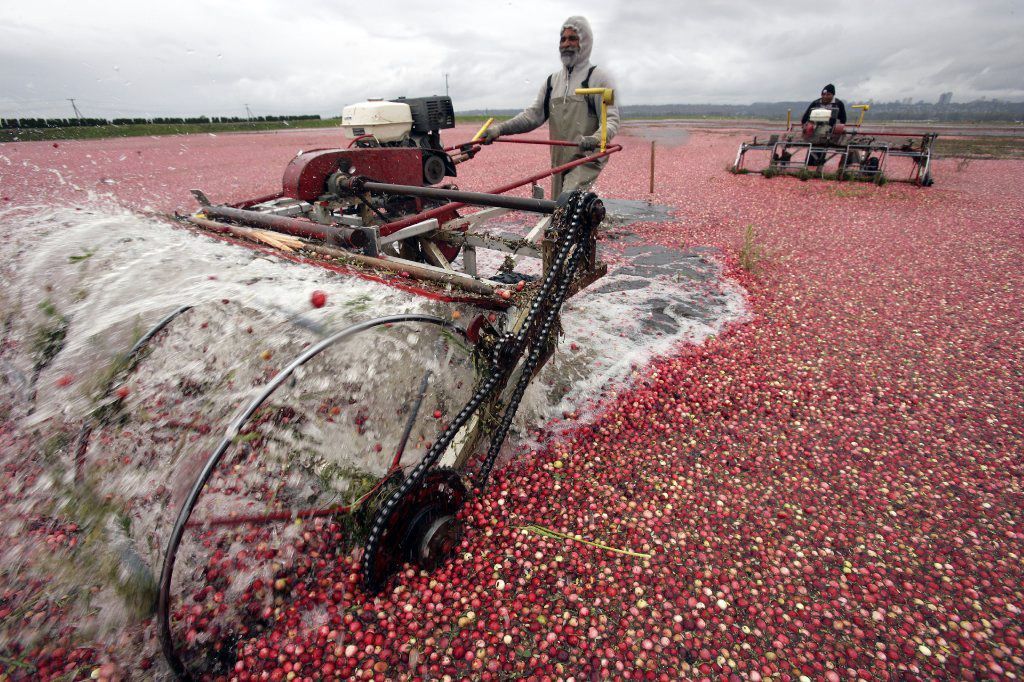Cranberries

A Thanksgiving Essential
Americans consume cranberries for Thanksgiving as a relish/sauce, in stuffing, in breads, and as part of numerous luscious desserts. A native berry to North America, the cranberry (Vaccinium macrocarpon) was undoubtedly present at the 1621 Plimoth Plantation Harvest Festival. Native Americans have been using these berries as a food, dye, and in medicine for 12,000 years. Cranberries were an important food source throughout its native range, northern North America across Canada, and eastern United States, south to
North Carolina (at high altitudes). They were called by a variety of names, "sassamenesh" (Wampanoag), “ibimi” (Cape Cod Pequot & Leni-Lenpa), “saytassah” (Narragansett), and “ataqua” or “anibimin” (Chippewa, Great lakes region). All the names translated about the same, “very sour berry”, or “bitter berry”.
Native Americans ate these berries, which are loaded with vitamin C, both dried and fresh. Because they contain benzoic acid, a natural preservative, the dried berries lasted for months. This allowed them to be used throughout the year in a variety of foods including pemmican (left), a mixer of crushed berries, dried meat or fish, and animal fat, “baked” in the sun. Pemmican was the original power food. It provided energy, lasted for months, and was easily carried on long journeys. Pemmican impressed the first European adventurers, and it quickly became a food staple of fur traders. Early New England settlers were familiar with similar European berries, and easily adapted the berries to their cuisine with a Native American twist. By the mid-1700s, with the growth of the slave trade, sugar became widely available in New England and cranberries were used more frequently in pies and tarts. It was at this time that our modern cranberry sauce was born.
A cranberry plant is a low–growing and trailing, woody vine that produces ground level runners (1-6 feet long). These runners produce short vertical stems called uprights. Flower buds form atop the uprights and sometimes from the runner ends. Blooming takes place in June making the cranberry bogs appear as a pink carpet buzzing with bees. The fruit begins to form in early July. It ripens to bright red in September and October. Within the fruit there are tiny pockets of air that allow the berries to float, an efficient seed dispersal strategy in a wet environment.
The plant is a perennial of the heath family. It only flourishes in a unique type of marsh soil. Old glacial kettle ponds that filled with sand, clay, and debris created the ideal acidic peat soil and wet conditions needed by the plant. Alternating layers of sand and organic matter are essential in productive cranberry bogs. Commercial growers will add sand to the bed surface every 2-5 years to encourage upright production and to maintain a high-yield. In contrast to normal agricultural soils, cranberry soil requires no tilling. Because the soil remains undisturbed, some plants may thrive for over 100 years.
Capt. Henry Hall of Dennis, MA was the first person to cultivate the berry. In 1816, he observed that the wild cranberries in his bogs grew better when sand blew over them. While initially criticized for raising cranberries, the idea eventually caught on. Landowners in southwest MA and especially on Cape Cod eagerly joined in. By 1888, the Cape Cod Cranberry Growers Association had been formed. “Cranberry Fever” was in full force by 1900 and the industry boomed. As late as 1927, the cranberry harvest remained so vital in MA that children could be excused from school to harvest the bogs.
Cranberry harvesting is very labor intensive. As demand increased, new harvesting tools were developed. The harvesting capabilities slowly progressed from intensive backbreaking handpicking to the snap scoop (1887) and the wooden scoop (1890s). Both tools required manually combing the vines while on one’s knees. The first mechanical harvester appeared in 1920 with limited success. In 1947, a walk-behind mechanical dry harvester increased productivity. But it was water harvesting, beginning in the late 1960s, that enabled an increase in harvest volume that expanded the berry's popularity and diversity.
Climate is critical to the plant. Cranberries love a moderately warm spring without a late frost, and a hot summer with only about an inch of rain a week. This allows the fruit to be pollinated and set. Once the berries have ripened into a rich red, commercial bogs are flooded. Mechanical beaters enter the water knocking the upright berries off the plants. The berries are floated into pens, vacuumed up, dumped through a grate where twigs and sticks are removed, and then poured into trucks to be driven to a factory where they are immediately frozen. Because wet harvest is hard on the berries, these berries are normally used in one of the many manufacturing process, such as, juice, sauce, etc. However, dry harvested berries are most often sold fresh.
Cranberries have a long history in New England, from the many centuries of multiple uses by Native Americans, to the European settlers who successfully cultivated them into a commercial product enjoyed throughout the world. The name "cranberries" is credited to the first English settlers. The plant's flowers reminded the settlers of a sandhill crane’s head drooping to the ground. Thus, they called the berry “craneberry”, which evolved into present day cranberry.

The Rest of the Story
The United States is the largest cranberry producer in the world. About half of all cranberries sold are from Wisconsin, with Massachusetts producing about a third. The remainder of the world's supply comes from Oregon, New Jersey, and Washington State, with a small percentage from Canada and Chile.













